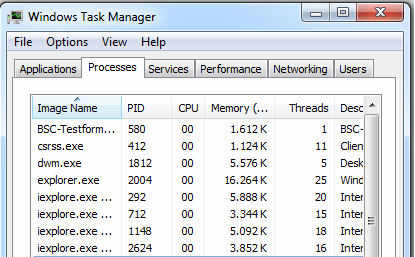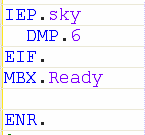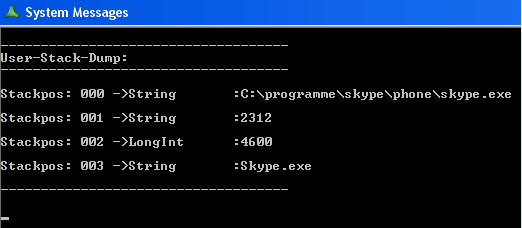Starting Guide
Applications, PID and TID
Understanding Applications, Processes and Threads

The running processes and Threads make all things that computers do.
What can we do with applications using the robot-scripts?
We can start an application in multiple ways. For example using:
We can kill an application using the commands:
We can check if an specified application is actually running.
IEP. / NEP. - If-Exists-Process
And finally we can enumerate/count all running processes using
Which is less often used.
Lets take a look into the task-manager, which applications/processes are currently running:

What we can see is that there are several processes with the same name "iexplore.exe".
But how do we find the one we need?
How can we select a specific process/application?
Rather then selecting a process "by name", we can use the process-ID (PID).
The PID is a number that is unique to each process. Having the PID, we can work with the process.
Using the PID we can do things like:
Find out which user has started the process:
we can wait until a process ends. Using
WPT. - Wait-Process-Termination
If we have just started a process - for example with -
then we can use
to be sure the process we need is running. A PID is a magic number when dealing with applications and processes. If you have the PID, you can do anything you want with that process. As long as you have the sufficient rights.
How do we get the PID from an process or application?
1. We may get the PID directly from the starting command. Only starting commands that wait until the process is running, can support filling #pid#. Therefore see the description of the starting command if it supports #pid#.
If we use:
EXE.?pfad\UltraVNC_1.0.9.6.1_Setup.exe
VAR.$$PID=#pid#
MBX.MY PID is: $$PID
we get the PID in the system variable #pid# automatically.
2. We get the PID from any window. It doesn't matter if its a Top-Level window or a control (child-window). If we have the window, we can get the PID like this:
STW.t|Testapp
' We'll put the PID of the process from that window
' into the variable $$PID using the GDF.-command
GDF.ap|$$PID
It does not need to be a Top-Window, it can be any actual localized window, try this
STW.t|Testapp
SCW.c|butto
GDF.ap|$$PID
' Will print the PID in the Debug-Area of the Editor
DBP.$$PID
ENR.
3. We can get the PID from the name of the EXE-File
VAR.$$FIL=?exepath\MR01.exe
GDF.fp|$$FIL|$$PID
' Will print the PID in the Debug-Area of the Editor
DBP.$$PID
ENR.
or we can use IEF. for that.
' Get the PID using IEP.
IEP.Testapp_01.exe
MBX.#pid#
ELS.
MBX. That Application is not running!
EIF.
ENR.
GDF. works with any process in the Task-Manager, no matter if that process has a window or not.
What makes IEP. (If exist process) so powerful?
IEP. primarly helps you to find out, if a process is running. For this you can specify the process in several ways, including the use of 3.2 Standard-Search Pattern.
Assume you use IEP. to check if there is a process like this:

Now IEP. finds such a process. But what is the real name of the process?
sky ... what?
We have just specified "sky". As IEP. uses Standards Search Patterns, any part of thereal name is valid.
The name of the process must only contain that phrase. We get this information if we take a look on the actual stack.

IEP. provides us with a lot of information about the found process. In position zero
IEP.x64.exe
MBX. Process ID is: #pid#
EIF.
If you have multiple EXE running with the same name, you can specify a number. If the EXE is found, the #pid# is set to the EXE's Process-ID. Please note that #tid# is always set to zero.
You can specify a full path, or only the filename or a part of it. If you search for a dll, then the extension ".dll" must be included in the pattern.
You can use NEP., the negative Form of this command (NEP. - Not Exists Process).
If a process is found, valuable information is placed on the actual stack. These include the full name and path of the found executable.
Below are two snapshots of the windows-taskmanager. Skype.exe has the PID (process-id) 4600. Its on the stack on position 02 in the picture above.
The 2312 which is on position 01 (picture above) is the parent-process, that is the process which has started skype.exe.
In the task manager, we can see that this is the PID of the windows-explorer. This way you can find out which process has started another process.
If you give IEP. a variable as third parameter, then the stack will not get the full path of the found file. You will find it in the given variable instead.
Please note that the 2.4 The global and local Stack as Que or as Stack will influence the sequence in which the items appear on the stack.

![]()
You can also use IEP. to verify, if a process with a specified PID is alive or not.
To do this, the Syntax is:
STS.GLOBAL
IEP.>1234
MBX.PID 1234 (Filename=$$000) is alive!
EIF.
